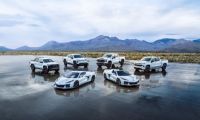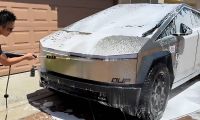As electric vehicles become more and more a part of the transportation discussion, we felt it would help some readers if we had a guide to the vocabulary, abbreviations, nicknames, and acronyms we throw around when discussing these vehicles. We are realists, not sticklers for technical perfection here at Torque News. We will offer the exact definition where need be, but we opt to emphasize the commonly-used definitions for some of the terms in the EV discussion. Feel free to offer updates and additions in our comments section. We will review and add them to our list periodically to keep it current.
Tip: If you are searching for a term here, we didn’t list them alphabetically. To find the term you want, use the control key (bottom left of most keyboards) and the F key at the same time to call up a search box on your screen. It usually appears in the top left of the screen. Type your term in and the search box will help you find the term in the story by highlighting where the word appears.
Electric Vehicle or EV: An electric vehicle, or EV, is considered by most industry experts to be any vehicle that can operate at any time using only electricity as its source of propulsion. There are many types of EVs. Not just one. For example, battery-electric vehicles, plug-in hybrid-electric vehicles, hybrid-electric vehicles, and fuel cell electric vehicles. We will define those below.
Alternative definition: Some battery-electric advocates (owners) will argue that only battery-electric vehicles are truly “electric vehicles.” To our minds, this is like a person arguing that only chicken noodle soup should be called soup.
Electrified Vehicle: When the term electrified vehicle is used, the term generally intends to convey a range of EV types. For example, if Toyota says, “By 2030 we expect fifteen percent of our new vehicle sales to be electrified vehicles,” the statements meant to convey that the vehicles will not just one type of electric vehicle technology, but instead a mix of EV technologies.
Internal Combustion Engine or ICE: The term ICE is commonly used to describe a traditional engine or powertrain used in vehicles. A gas or other liquid-fueled engine that does not have any electric operating capacity is what is meant. The term derives its origin from the days when early engines like steam engines were external combustion, and then the type of enclosed combustion engines that we use in cars followed. The combustion in a car is contained within a cylinder and piston configuration that then uses the force from gas expansion to push on a crankshaft via a connecting rod. Want to blow your mind? Google Stirling engine.
Battery Electric Vehicle or BEV: An electric vehicle that is powered only by its onboard battery. In other words, an EV that only uses batteries. Examples on sale today include the Chevy Bolt, Mustang Mach-E, and every Tesla model.
Plug-in Hybrid-Electric Vehicle or PHEV: Pronounced “Pee-hev” or “fev.” An electric vehicle that has the ability to operate on either battery power alone, or to operate as a hybrid. PHEVs usually use a gasoline engine as well as a battery-electric drive. They offer the longest total range of the EV types, up to 600 miles in popular models, and have very high efficiency ratings. For example, the Toyota Prius Prime PHEV has a 133 MPGe rating, higher than most BEVs. It is important to note that most modern PHEVs don’t use a traditional internal combustion engine and transmission. Rather, most are closer to zero maintenance and have been proven in studies to have maintenance and repair costs equal to or better than some BEVs. Here is an explanation of some common misconceptions about PHEVs.
Hybrid or Hybrid-Electric Vehicle or HEV: A hybrid-electric vehicle is the same thing as a hybrid. For three decades hybrids have combined a liquid-fueled engine with an electric motor system to provide outstanding fuel economy and limited EV-only operation. The Prius is the iconic hybrid. There are two big secrets to their success; Regenerative braking and continuously variable transmissions (CVTs) or another novel transmission technology.
Extended Range Electric Vehicle or EREV: Extended Range Electric Vehicles like the Chevy Volt and BMW i3 combine an on-board liquid fuel engine with a robust electric drive. They differ slightly from PHEVs in that they primarily use the engine as a generator to charge the battery, rather than directly propel the vehicle via the hybrid drive system. In this way, they are like electric vehicles that have an onboard charger. Once thought extinct, Mazda recently announced a new EREV for 2022.
Fuel Cell Electric Vehicle or FCEV: Fuel Cell Electric Vehicles use a fuel cell and hydrogen to generate electricity and power a vehicle. Each also carries a battery. The fuel cell does not usually directly drive the vehicle. Toyota, General Motors, and Hyundai all have FCEV vehicles in various stages of the product lifecycle. Critics (and there are legions) say the refueling network will preclude widespread adoption. However, FCEVs may find a role in the development of zer0-local-emissions semi tractors. Particularly for local routes, called drayage.
Miles Per Gallon Equivalent MPGe: Miles Per Gallon Equivalent is a unit of measure, or metric, that the EPA developed to help consumers cross-shop various types of vehicles. The group deines MPGe by saying, where 33.7 kWh = 1 gallon of gasoline. Since almost nobody intuitively understands what a kWh is, it is only helpful as a comparison. The idea is that MPGe can give a consumer an idea how EV, PHEV, EREV, FCEV, and ICE vehicles compare to one other with regard to “fuel economy.” The metric is imperfect but has a place in the green vehicle consumer selection space. Read how it was developed at the EPA’s website.
Electric Vehicle Charger or “Charger”: The word charger has more than one meaning. The majority of EV owners refer to the device that provides the power to an electric vehicle as a “charger.” EVangelists will sometimes correct those who use the term this way and say that technically the charger is inside the vehicle. These are the same people that only consider BEVs electric vehicles but use the word organic in 12 different ways. A charger is also the internal power system that converts incoming electrons to battery power. Check out this deep dive on the subject of the word “Charger.”
Electric Vehicle Supply Equipment or EVSE: An EVSE is most commonly referred to by EV owners as a “charger.” The device that is external to an EV and provides incoming electrons to then go into the vehicle’s charger to charge the battery.
Supercharger: Tesla has built out its own captive high-amperage EV chargers for its customers to use exclusively. They are called Superchargers. Originally promised to be free for customer use, Tesla now charges for charging. Some owners still have vehicles grandfathered in from the good old days when it was free.
Range: Range is the distance a vehicle can travel without stopping for energy. In ICE vehicles it is usually 300 to 400 miles. Most EV models have a range of between 225 and 325 miles. PHEVs have the longest ranges and are up to 600 miles in popular models. PHEVs will usually be rated two ways, EV-only range, typically 25 to 50 miles, and total combining EV and hybrid operation.
Winter EV Range: It is important to know that the ranges that folks speak about with regard to EVs are a bit different than those in a liquid-fueled vehicle. The EPA offers just one big range number as a reference, but it is rarely accurate unless you live in a place where the temps are always around 70 F. Cold weather can impact the range of an EV, and it can impact the predicted range in the vehicle display even more. We created this deep dive to give you more info on winter EV range.
Torque: Torque is easy to understand. It is a twisting motion, or “moment,” as engineers call it. Step on the end of a broomstick overhanding a wall by one foot. Then put a one-pound weight on the overhung end and you have created a torque of one foot-pound. Torque is vital to understanding why EVs beat ICE cars in driving satisfaction. They have more torque at lower speeds and thus feel stronger. For example, the Jeep Wrangler 4Xe PHEV has 470 ft-lbs of torque. No Wrangler offers more torque, not even its V8 and diesel models.
Regenerative Braking: Regen braking is the key to the efficiency gains that hybrids, PHEVs, and BEVs have over conventional vehicles. When the brakes are applied in an EV, the electric motors become generators and recoup power that would otherwise be wasted by the friction brakes. The amount of energy recaptured is substantial. In some vehicles, the regen braking force can be adjusted by the driver using paddle shifters (or a boring button).
One Pedal Driving: The great thing about EVs is that they can recapture the energy otherwise lost to braking. Since regenerative braking is done by a motor acting as a generator, it can also be adjusted to be aggressive and slow the vehicle. If you’ve ever downshifted an ICE car to slow it, you know that feeling. Automakers can program EVs so that the braking force is there when you lift off the accelerator. This can make it possible to drive the car pretty much with “One pedal.” If you are ever in an EV, give it a try. Most owners love it and use it as their default setting. If you opt not to use it, you can select a mode that feels like any other car.
Preconditioning a Cabin: EVs can use the electric energy onboard to heat or cool the cabin. It works a lot like a remote start on a traditional vehicle. You program a time or use an app to initiate cabin preconditioning and the HVAC system will come on and either warm up or cool off the cabin. Doing this while you are plugged into a charger means that you won’t then have to use energy in your battery to bring the cabin to your desired temperature. Thus, preconditioning your cabin extends your driving range.
Not happy with our definitions of a term? Feel free to check out this similar, but more cumbersome list of energy-related terms offered by the EPA. Maybe the definition you hope to find will appear on the EPA's list.
If you have a term you wish to have defined, or if you wish to offer a correction for our consideration, please feel free to use the comments below. We will make this story a "living document," to be updated and added to each week.
John Goreham is a long-time New England Motor Press Association member and recovering engineer. John's interest in EVs goes back to 1990 when he designed the thermal control system for an EV battery as part of an academic team. After earning his mechanical engineering degree, John completed a marketing program at Northeastern University and worked with automotive component manufacturers, in the semiconductor industry, and in biotech. In addition to Torque News, John's work has appeared in print in dozens of American newspapers and he provides reviews to many vehicle shopping sites. You can follow John on TikTok @ToknCars, on Twitter, and view his credentials at Linkedin












